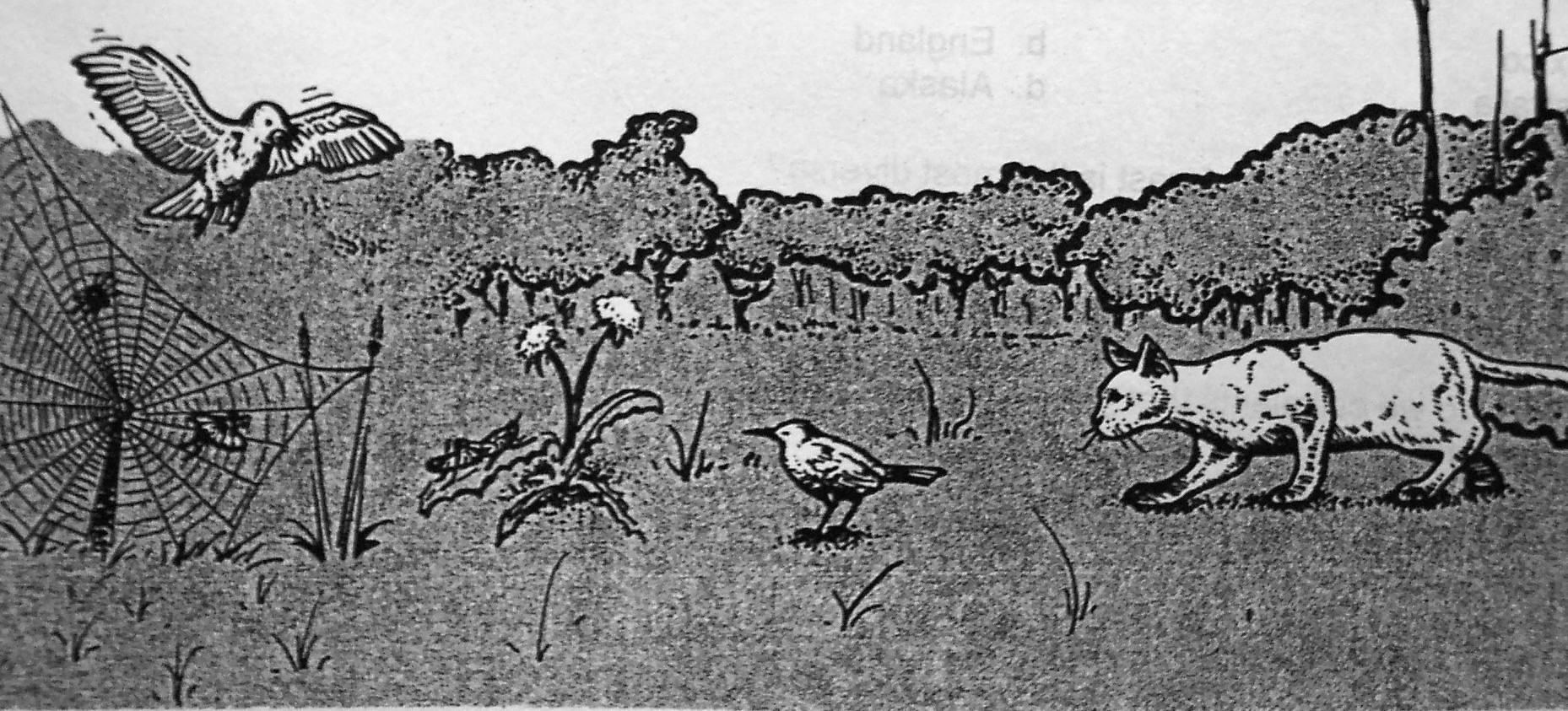
Name __________________
Period _____ Date ________
Ecology Test
Matching
Each response will be used only once. All responses will be used. Write the correct letter on the line.
| 1. _____ The study of
living things and their environment 2. _____ The animal and plant populations that live in a certain place 3. _____ The greatest number of organisms an area can support 4. _____ The type of environment suitable for an organism 5. _____ The area where organisms of a certain type are found 6. _____ Organisms that can be seen only with a microscope 7. _____ All the organisms of the same type living in a certain place 8. _____ The way an organism fits into its habitat 9. _____ All the living and non-living things that surround an organism 10. _____ A community and its interactions with the environment |
a. niche b. carrying capacity c. ecology d. ecosystem e. environment f. microorganism g. population h. community i. habitat j. range |
Multiple Choice
Choose the one best answer and write the corresponding letter on the line.
11. _____ What do we call the process by which water, in any form, falls from the atmosphere to the Earth’s surface?
a. Evaporation
b. Transpiration
c. Runoff
d. Precipitation
12. _____ When water evaporates from plants, what do we call this?
a. Evaporation
b. Transpiration
c. Runoff
d. Precipitation
13. _____ What might an animal use to be better suited in its environment to stay safe from predators?
a. Camouflage
b. Thick fur
c. Move slowly
d. Have bright colors
14. _____ What do we call green plants that make their own food that other organisms depend on?
a. Primary Consumers
b. Decomposers
c. Scavengers
d. Producers
15. _____ What do we call animals that eat animals that they find already dead?
a. Primary Consumers
b. Secondary Consumers
c. Scavengers
d. Producers
16. _____ Where do producers get most of their energy from?
a. Water
b. Soil
c. The Sun
d. Scavengers
17. ____ Which of the following is at the top of the energy pyramid?
a. Omnivores
b. Carnivores
c. Herbivores
d. Producers
18. _____ Which biome gets less than 25 centimeters of rain per year?
a. Desert
b. Taiga
c. Tundra
d. Grassland
19. _____ Which biome has permafrost?
a. Desert
b. Taiga
c. Tundra
d. Grassland
20. _____ Which biome has trees that drop their leaves every fall and grow new leaves again every spring?
a. Tropical Rain Forest
b. Deciduous Forest
c. Coniferous Forest
d. Taiga
21. _____ Where is most of the Earth’s water found?
a. Lakes and Rivers
b. Oceans
c. Polar Ice Caps
d. Groundwater
22. _____ Which of the following is NOT a renewable resource?
a. Trees
b. Fossil Fuels
c. Water
d. Oxygen
23. _____ What do we call the loss of topsoil by wind or water?
a. Evaporation
b. Transpiration
c. Erosion
d. Strip Cropping
24. _____ What causes acid rain?
a. Air Pollution
b. Water Pollution
c. Land Pollution
d. The Ozone Layer
25. _____ Where did the Exxon Valdez Oil Spill occur?
a. Mexico
b. England
c. Australia
d. Alaska
26. _____ Which layer of the rainforest is the most diverse?
a. The Forest Floor
b. The Understory
c. The Canopy
d. The Emergent Layer
27. _____ What do we call plants that grow on trees in the rainforest and get their nutrients from decayed leaves, algae and moss?
a. Lianas
b. Morphos
c. Epiphytes
d. Hanging Plants
28. _____ Which rainforest animal discards its tail when grasped?
a. Gecko
b. Alligator
c. Iguana
d. Brazilian Rainforest Rats
True/False
Write true of false on the line.
29. _____ Water is considered a renewable resource.
30. _____ Ecology is the study of ONLY living things.
31. _____ Plants take in oxygen and give off carbon dioxide.
32. _____ Primary consumers eat only secondary consumers.
33. _____ A food web is like many food chains put together.
34. _____ The Earth’s ozone layer is being destroyed by CFCs.
Free Response
35. Draw a diagram of the carbon dioxide/oxygen cycle. Briefly explain what is happening in this cycle.
Use the following picture to answer questions 36-38.

36. Fill in the blanks to show the proper sequence of the food chain in this illustration.
____________ » ____________ » ____________ » ____________ » ____________
37. Label each organism from the illustration as a producer, consumer, or decomposer.
a. Cat _________________
b. Flower _________________
c. Bird _________________
d. Grasshopper _________________
e. Spider _________________
38. What would happen if all of the spiders were removed from this environment?
39. Give 2 reasons why the rainforest is important to all humans around the world.
40. Give 3 examples of animals or plants that are well suited for their environments and tell why they are well suited to survive where they do. (Example: Polar bears have thick fur to keep them warm in their cold environment.)